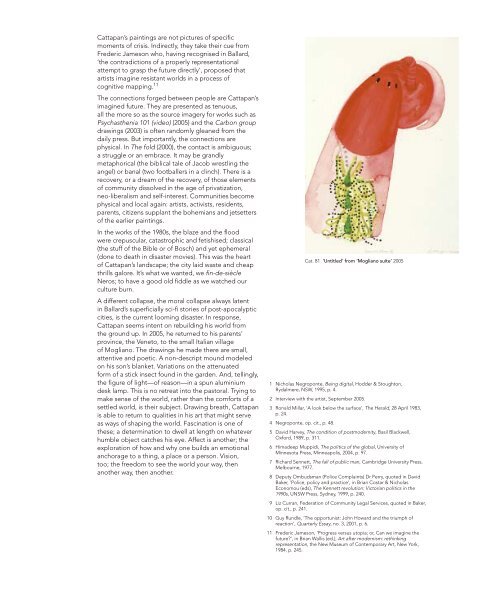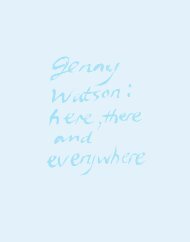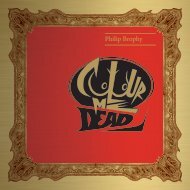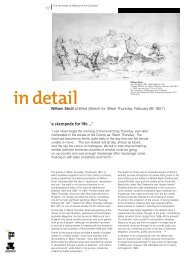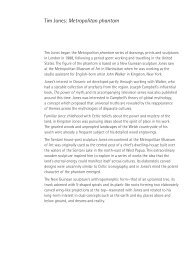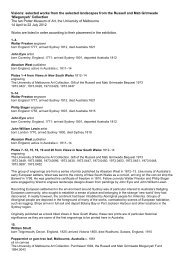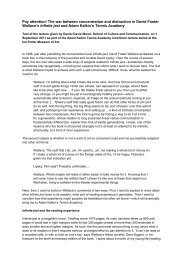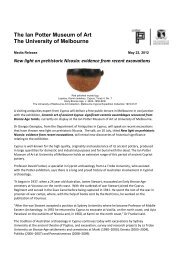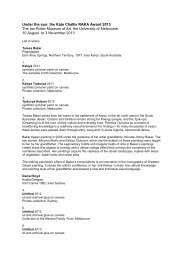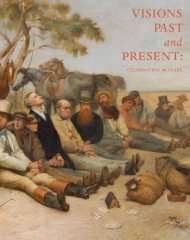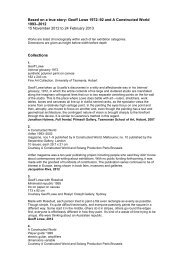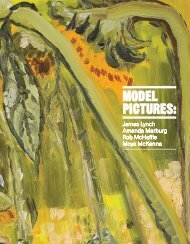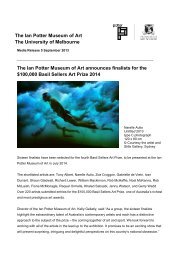The drowned world Jon Cattapan works and collaborations
Catalogue - Ian Potter Museum of Art - University of Melbourne
Catalogue - Ian Potter Museum of Art - University of Melbourne
- No tags were found...
You also want an ePaper? Increase the reach of your titles
YUMPU automatically turns print PDFs into web optimized ePapers that Google loves.
<strong>Cattapan</strong>’s paintings are not pictures of specific<br />
moments of crisis. Indirectly, they take their cue from<br />
Frederic Jameson who, having recognised in Ballard,<br />
‘the contradictions of a properly representational<br />
attempt to grasp the future directly’, proposed that<br />
artists imagine resistant <strong>world</strong>s in a process of<br />
cognitive mapping. 11<br />
<strong>The</strong> connections forged between people are <strong>Cattapan</strong>’s<br />
imagined future. <strong>The</strong>y are presented as tenuous,<br />
all the more so as the source imagery for <strong>works</strong> such as<br />
Psychasthenia 101 (video) (2005) <strong>and</strong> the Carbon group<br />
drawings (2003) is often r<strong>and</strong>omly gleaned from the<br />
daily press. But importantly, the connections are<br />
physical. In <strong>The</strong> fold (2000), the contact is ambiguous;<br />
a struggle or an embrace. It may be gr<strong>and</strong>ly<br />
metaphorical (the biblical tale of Jacob wrestling the<br />
angel) or banal (two footballers in a clinch). <strong>The</strong>re is a<br />
recovery, or a dream of the recovery, of those elements<br />
of community dissolved in the age of privatization,<br />
neo-liberalism <strong>and</strong> self-interest. Communities become<br />
physical <strong>and</strong> local again: artists, activists, residents,<br />
parents, citizens supplant the bohemians <strong>and</strong> jetsetters<br />
of the earlier paintings.<br />
In the <strong>works</strong> of the 1980s, the blaze <strong>and</strong> the flood<br />
were crepuscular, catastrophic <strong>and</strong> fetishised; classical<br />
(the stuff of the Bible or of Bosch) <strong>and</strong> yet ephemeral<br />
(done to death in disaster movies). This was the heart<br />
of <strong>Cattapan</strong>’s l<strong>and</strong>scape; the city laid waste <strong>and</strong> cheap<br />
thrills galore. It’s what we wanted, we fin-de-siècle<br />
Neros; to have a good old fiddle as we watched our<br />
culture burn.<br />
A different collapse, the moral collapse always latent<br />
in Ballard’s superficially sci-fi stories of post-apocalyptic<br />
cities, is the current looming disaster. In response,<br />
<strong>Cattapan</strong> seems intent on rebuilding his <strong>world</strong> from<br />
the ground up. In 2005, he returned to his parents’<br />
province, the Veneto, to the small Italian village<br />
of Mogliano. <strong>The</strong> drawings he made there are small,<br />
attentive <strong>and</strong> poetic. A non-descript mound modeled<br />
on his son’s blanket. Variations on the attenuated<br />
form of a stick insect found in the garden. And, tellingly,<br />
the figure of light—of reason—in a spun aluminium<br />
desk lamp. This is no retreat into the pastoral. Trying to<br />
make sense of the <strong>world</strong>, rather than the comforts of a<br />
settled <strong>world</strong>, is their subject. Drawing breath, <strong>Cattapan</strong><br />
is able to return to qualities in his art that might serve<br />
as ways of shaping the <strong>world</strong>. Fascination is one of<br />
these; a determination to dwell at length on whatever<br />
humble object catches his eye. Affect is another; the<br />
exploration of how <strong>and</strong> why one builds an emotional<br />
anchorage to a thing, a place or a person. Vision,<br />
too; the freedom to see the <strong>world</strong> your way, then<br />
another way, then another.<br />
1 Nicholas Negroponte, Being digital, Hodder & Stoughton,<br />
Rydalmere, NSW, 1995, p. 4.<br />
2 Interview with the artist, September 2005.<br />
3 Ronald Millar, ‘A look below the surface’, <strong>The</strong> Herald, 28 April 1983,<br />
p. 24.<br />
4 Negroponte, op. cit., p. 48.<br />
Cat. 81 ‘Untitled’ from ‘Mogliano suite’ 2005<br />
5 David Harvey, <strong>The</strong> condition of postmodernity, Basil Blackwell,<br />
Oxford, 1989, p. 311.<br />
6 Himadeep Muppidi, <strong>The</strong> politics of the global, University of<br />
Minnesota Press, Minneapolis, 2004, p. 97.<br />
7 Richard Sennett, <strong>The</strong> fall of public man, Cambridge University Press,<br />
Melbourne, 1977.<br />
8 Deputy Ombudsman (Police Complaints) Dr Perry, quoted in David<br />
Baker, ‘Police, policy <strong>and</strong> practice’, in Brian Costar & Nicholas<br />
Economou (eds), <strong>The</strong> Kennett revolution: Victorian politics in the<br />
1990s, UNSW Press, Sydney, 1999, p. 240.<br />
9 Liz Curran, Federation of Community Legal Services, quoted in Baker,<br />
op. cit., p. 241.<br />
10 Guy Rundle, ‘<strong>The</strong> opportunist: John Howard <strong>and</strong> the triumph of<br />
reaction’, Quarterly Essay, no. 3, 2001, p. 6.<br />
11 Frederic Jameson, ‘Progress versus utopia; or, Can we imagine the<br />
future?’, in Brian Wallis (ed.), Art after modernism: rethinking<br />
representation, the New Museum of Contemporary Art, New York,<br />
1984, p. 245.


